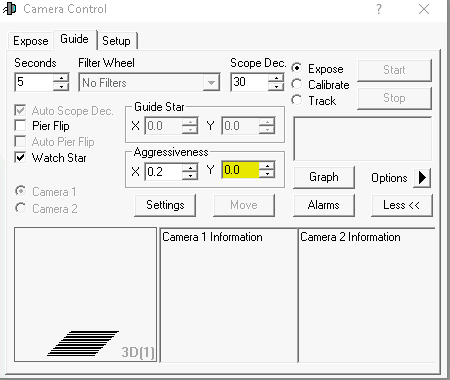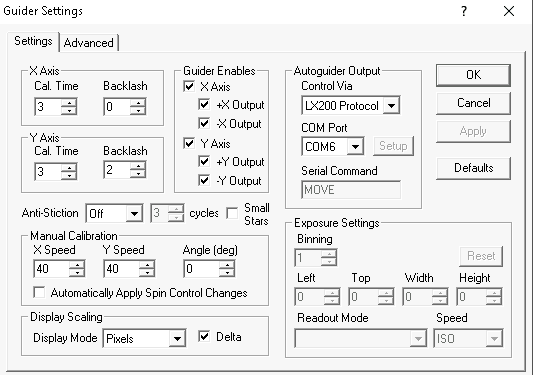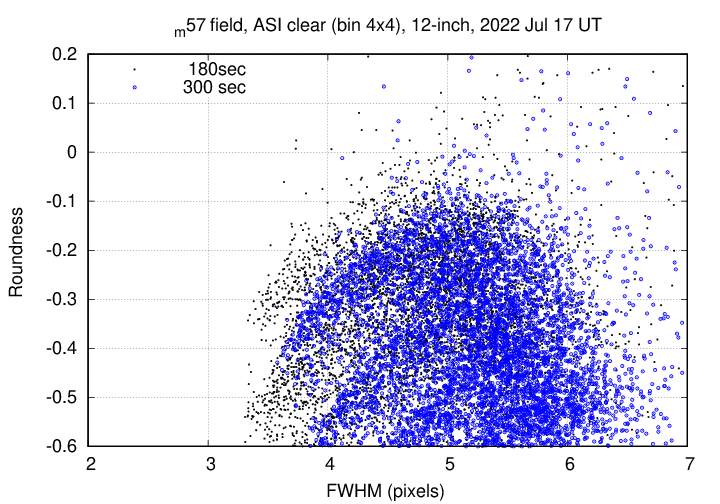
On the night of July 16/17, 2022, under good conditions, I finally put the autoguider into operation on the 12-inch telescope. Details of the setup and description of some test data are shown below.
Executive summary:
The first step was to focus the main telescope on a brightish star. That done, I moved the star into the field of the finder and shifted the guide camera backward in the OAG's slide tube until the star was close to focus; I then used the focusing ring on the OAG to bring the star into a good focus. At this position, the focusing ring was at position 5.0.
Next, I tried to figure out how to connect MaximDL to the telescope properly. The old settings (see second figure below) were for LX200 Protocol and port COM4, but after a bit of experimentation, I discovered that the current setup requires communication with port COM6.
That done, I first set the handpaddle slew speed to 1x = Guiding and then manually requested motions of 1 or 2 seconds in each of the +X, -X, +Y, -Y directions. It became clear that a motion of 2 seconds would move stars by 80 pixels in each direction, though only one of the Dec directions worked properly due to backlash. This meant that the "Speed" setting for MaximDL's guiding routines would be 40 (meaning "40 pixels corresponds to 1 second of motion").
I also discovered that guiding works properly only when the current guide camera is set to 2x2 binning. I don't understand this, but I do remember that it was necessary in years past with a similar setup.
Having set things up properly, I was able to verify that the guiding routines would keep a star centered in the guide box; if I nudged the telescope a bit, the guide routines would move the star back into the center. Note the small value for aggressiveness in X, which requires that the option "Fine Aggressiveness" be checked. I set the aggressiveness in Y to zero to prevent the telescope from trying to move in Dec, due to the backlash.


These settings are saved in a configuration file with the name
I then moved to the field of M57 to take a few sample images with different long exposure times, to see how well the telescope could track. I took 5 images each at exposure times of 60, 180, and 300 seconds. The montage below shows a closeup near the center of one image for each exposure time: 60 seconds at left, 180 seconds in the middle, 300 second at the right. The faintest stars visible in the images below are close to mag G = 18.

The figures and table below show quantitative results from these test images. The number of stars detected in total at each exposure time is about 5500 (so, roughly 1000 stars in each image). One can see a slight decrease in the quality of the PSF as the exposure time grows longer.


Exposure time (sec) Star FWHM (pix) Star Roundness
---------------------------------------------------------------------
60 4.49 +/- 0.76 -0.22 +/- 0.15
180 4.83 +/- 0.70 -0.32 +/- 0.14
300 5.25 +/- 0.71 -0.38 +/- 0.14
---------------------------------------------------------------------
Comparing the positions of stars in these images against those of stars in the Gaia EDR3 catalog, and using a linear plate model, I find a plate scale of 1.036 arcsec/pixel for the ASI camera in this arrangement. Note that this is slightly smaller than the value of 1.052 derived for the same camera WITHOUT the filter drawer in the optical train. That makes sense: since the camera is now slightly (20 mm or so) farther from the primary mirror, an object of a given angular size in the sky should be projected into a somewhat larger image on the focal plane. That same angular size, spread out over a slightly larger number of pixels, will yield a smaller angular size per pixel.
Last modified 7/15/2022 by MWR.